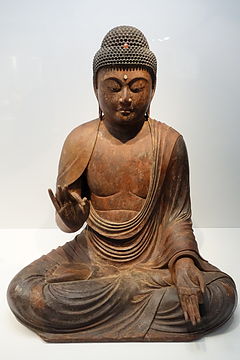Amithaba
| Amitābha | |
|---|---|

|
|
| Sanskrit | Amitābha, Amitāyus |
| Chinese | 阿彌陀佛 (Traditional) / 阿弥陀佛 (Simplified) Pinyin: Āmítuófó Wade-Giles: A-mi-t’uo Fo |
| Japanese | 阿弥陀仏 Amida Butsu |
| Korean | 아미타불 Amita Bul |
| Mongolian | ᠴᠠᠭᠯᠠᠰᠢ ᠦᠭᠡᠢ ᠭᠡᠷᠡᠯᠲᠦ Цаглашгүй гэрэлт Tsaglasi ügei gereltu Одбагмэд Odbagmed Аминдаваа Amindavaa Аюуш Ayush |
| Tibetan | འོད་དཔག་མེད་ 'od dpag med Ö-pa-me |
| Vietnamese | A-di-đà Phật |
| Information | |
| Venerated by | Mahayana, Vajrayana |
| Attributes | Infinite Light or Immeasurable Radiance |
| Shakti | Pandara |
|
|
|
Amitābha (Sanskrit pronunciation: [əmiˈt̪aːbʱə]), also Amida or Amitāyus, is a celestial buddha according to the scriptures of Mahāyāna Buddhism. Amitābha is the principal buddha in Pure Land Buddhism, a branch of East Asian Buddhism. In Vajrayana Buddhism, Amitābha is known for his longevity attribute, magnetising red fire element, the aggregate of discernment, pure perception and the deep awareness of emptiness of phenomena. According to these scriptures, Amitābha possesses infinite merits resulting from good deeds over countless past lives as a bodhisattva named Dharmakāra. Amitābha means "Infinite Light" so Amitābha is also called "The Buddha of Immeasurable Life and Light".
According to the Larger Sūtra of Immeasurable Life, Amitābha was, in very ancient times and possibly in another system of worlds, a monk named Dharmakāra. In some versions of the sūtra, Dharmakāra is described as a former king who, having come into contact with Buddhist teachings through the buddha Lokeśvararāja, renounced his throne. He then resolved to become a buddha and so to come into possession of a buddhakṣetra ("buddha-field", a realm existing in the primordial universe outside of ordinary reality, produced by a buddha's merit) possessed of many perfections. These resolutions were expressed in his , which set out the type of buddha-field Dharmakāra aspired to create, the conditions under which beings might be born into that world, and what kind of beings they would be when reborn there.
...
Wikipedia
